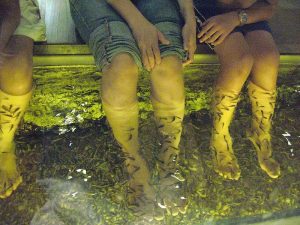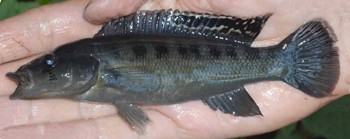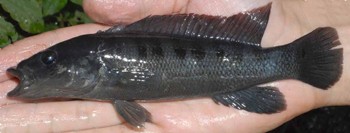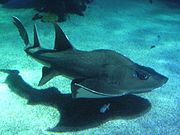Tag Archives: Aquarium
At long last, a vaccine offers hope of preventing Ich
According to new research presented by Dehai Xu, Ph.D. at the 240th National Meeting of the American Chemical Society (ACS)*, a vaccine against the feared ich disease might be available in the foreseeable future.
Ich is a disease dreaded by hobby aquarists and professional fish farmers alike. It is caused by the ciliated protozoan Ichthyophthirius multifiliis (hence the name ich) and can easily kill of all the fish in an aquarium or fish pond. Fortunately, it seems to be unable to infect humans. Among aquarists, it is chiefly known as White Spot Disease since the parasites cause small white nodules to form on the skin and in the gills of infested fish.
Today, ich outbreaks in large commercial fish farms are often treated by adding hundreds of gallons of a formaldehyde solution to the water. This is far from an ideal solution, since formaldehyde can be toxic to both humans and fish. It is classified as a known human carcinogen by the WHO International Agency for Research on Cancer (IARC) and is associated with both nasal sinus cancer and nasopharyngeal cancer. And as anyone who has ever combated ich in an aquarium knows, ich treatment is something you have to do over and over again since the parasite is usually only sensitive to treatment during one of its multiple life stages. This means repeatedly adding large quantities of formaldehyde solution to the pond. Even when formaldehyde ich treatment is successful, it provides no long-lasting effects since the fish develops no immunity. If new outbreaks occur, a new treatment cycle has to be carried out.
It is therefore no surprise that the series of vaccine tests carried out by Dr. Xu and his colleagues Dr. Phillip Klesius and Dr. Craig Shoemaker, who are with the U. S. Department of Agriculture’s Agricultural Research Service (ARS) in Alabama, have sparked vibrant interest within the aquatic world. For anyone from commercial fish farmers to public aquaria and hobby fish keepers, an ich vaccine would be a dream come true.
“Outbreaks of the parasitic disease caused by Ichthyophthirius (Ich) can result in losses of 50-100 percent of fish,” Dr Xu explained while presenting the team’s findings at the ACS meeting. “The disease is very common, and almost every home fish hobbyist has encountered it. Once the parasite infects fish, and starts growing in the skin, fins, and gills, there is no really effective treatment. Ich causes losses estimated at $50 million annually. It would be much better to prevent the disease. To vaccinate against Ich, you would need much less medication, and it would not pose an apparent threat to the environment. And you would need just one treatment to make the fish immune for life.”
In their efforts to develop a vaccine, Xu and his colleagues have focused on the use of so-called trophonts.
The ich protozoa goes though three life stages:
• The ich trophozoite feeds inside the nodule (”the white spot”) on the skin or gill of the fish.
• The ich trophozoite falls off and becomes an ich tomont, i.e. it enters an encapsulated dividing stage. During this stage, the tomont is attached to plants, gravel or other objects in the environment.
• The ich parasite will then start dividing itself, producing trophonts. The trophonts will move around freely in the water, looking for fish to infect.
Trophonts burrow into the skin and fills of a fish and start to feed, thus completing the cycle. When Xu, Klesius and Shoemaker began their research project very little was known about how fish develop protective immunity to trophonts, so the researchers basically had to start from scratch.
Eventually, they were able to show that vaccination with live ich theronts and trophonts killed with high-frequency sound waves stimulated production of protective antibodies in channel catfish (Ictalurus punctatus)
“This study demonstrated that vaccines against Ich induced protective immunity and could provide a unique solution to prevent this parasitic disease through vaccination,” Xu said. “An Ich vaccine would have great impact by preventing the disease, minimizing loss of valuable fish and increasing profitability of aquaculture.”
Injecting fish in a laboratory setting is one thing, administering a vaccine to thousands or even millions of fish in a huge commercial farm is another, so the next goal will be to find a way of carrying out large-scale vaccinations. It might for instance be possible to produce a large quantity of Ich antigen and then creating a vaccine that can be administered as food or in a “bath”.
For aquarists however, injecting each fish with the vaccine might actually be a feasible solution, provided of course that an injectable vaccine would be produced for the aquarium market.
Cold is Killing Millions of Fish in Bolivia
If you think you don’t like the cold, think of the fish! Somewhere in the neighborhood of six million fish have perished in three different rivers of Bolivia due to intense cold. This cold snap has been passing through the country for the last couple of weeks.
The situation is so dire in fact, that the authorities in the eastern Bolivian province of Santa Cruz have issued an alert. This alert came after fish had died in Grande, Pirai, and Ichilo rivers that run through the tropical region.
This is a real “environmental calamity” which was caused by the absolute lowest temperatures seen in Santa Cruz over the past 50 years, Governor Ruben Costas informed journalists.
Costas went on to say that experts in the field have discovered that the rivers are incredibly polluted by the carcasses of dead fish, and he has warned the locals not to use those waters.
This cold snap, which has had the Southern Cone of South America in it’s death grip for the past month, has caused a substantial decrease in the temperatures in both southern and eastern Bolivia. So drastic a change, that the temperature even dropped below 0 degrees Celsius.
The weather department of Bolivia has predicted that the eastern and southern parts of the country will continue to be out in the cold for the rest of the week.
Lynx Nudibranch, AKA Phidiana Lynceus, Gets Video Debut:
The Lynx Nudibranch, known in scientific circles as Phidiana lynceus, is a rather interesting marine animal. It can be amazingly efficient at getting rid of hydroid pests, but it must have access to a continuous source of food. After this amazing sea creature digests the stinging hydroids, the Lynx Nudibranch is actually able to incorporate the eaten (and thus digested) hydroid nematocysts into its own set of spiked cerata, which it then turns around and uses it for its own protection.
It’s almost as if you were to eat a king cobra, and then somehow survived the ordeal, and then became deadly like the king cobra… Well, sort of but not really.. If you would like more information on the matter, there are many marine biologists who can explain the process to you.
Anyway the Lynx Nudibranch in question was recently captured on high definition video by Coral Morphologic. The video, placed on Vimeo’s HD Channel, shows the lynch nudibranch chowing down on hydroids on top of an oyster, known as Spondylus americanus.
The clip which was recently put up there by the crew over at Morphologic was so stunning it was given the honor of being among the best, and who can argue with that? Congratulations are in order all around.
A New New York Bill May Ban Flesh Eating Fish Pedicures
The controversial use of live fish to chew away dead skin in pedicures may be banned in New York State for health and safety issues which have been proposed in a new bill.
The procedure in question was actually developed in Turkey, as a way to take care of a variety of ailments of the skin, such as psoriasis, consists of the feet being plunked into a tank of water which contains two different kinds of small fish. These rather hungry fish then proceed to eat away dead skin while leaving the healthy skin alone.
These “Fish Pedicures” are illegal in at least 14 different states, comments Senator Jeff Klein, of the Bronx and Westchester, who originally proposed the ban. The basis of the ban rests on the concern that fungal infections may be passed by unsanitized fish in unclean water. Of course the animal rights groups have jumped on the band wagon, pushing to outlaw the use of fish in pedicures as it is inhumane.
Robin Ross, the president of the New York Podiatic Medical Association, had this to say during a telephone interview: “I do not recommend it to anyone who has any diabetes or any immuno-compromised condition such as AIDS or cancer, because of the risk of infection. The fish are defecating and urinating in that water and you’re sticking your feet in it.” ”
The New York Department of State has gone on the record, saying that it is not aware of any of the 20,000 plus licensed nail salons engaging in such an activity. Apparently it is only being done on the down low, in backrooms of New York City.
Brand New Clownfish From Pacific Described
Researchers have described a brand new kind of clownfish, which belongs in the skunk clown group.
Douglas Fenner, Joshua Drew, and Gerald Allen, described this new clownfish as Amphiprion pacificus in their report which was recently published in Aqua, the International Journal of Ichthyology.
Amphiprion pacificus is now being described by scientists who took a look at four specimens which were roughly 4 to 5 centimeters long, and were caught in the western Pacific Ocean, between Tonga and Wallis Island.
However, it should be noted that this “new” fish was also photographed by divers on the coral reefs in Samao and Fiji.
This new species which has been described is almost identical to Amphiprion akallopisos, which makes its home in the Indian Ocean.
Both species of fish have a slightly pinkish brown body and a white stripe along their backs.
Despite the fact that they are almost identical in appearance, genetic testing has suggeste that Amphiprion pacificus is more closely related to Amphiprion sandaracinos, an anemonefish which lives in the Western Australia and indo-Malayan region of the world.
The authors were quoted as saying: “Aside from genetic differences A. sandaracinos differs from A. pacificus in having a uniform orange colouration and the white forehead stripe extends onto the upper lip.
“There also appears to be modal differences in the number of soft dorsal and anal rays (usually 19 versus 18 and 13 versus 12 respectively for A. pacificus and A. sandaracinos).”
If you are interested in learning more about this new discovery, feel free to check out: Allen GR, Drew J and D Fenner (2010) – Amphiprion pacificus, a new species of anemonefish (Pomacentridae) from Fiji, Tonga, Samoa, and Wallis Island, pp. 129-138. Aqua, International Journal of Ichthyology, Volume 16, Issue 3 – 15 July 2010.
A New Species of Hemigrammus Tetra Has Been Described:
A brand spanking new species of Hemigrammus tetra has been categorized, analyzed and described by a group of ichthyologists from Brazil. The new species makes its home in the Tocantins River drainage out in the central area of Brazil.
This tetra Hemigrammus, dubbed Hemigrammus tocantinsi, was described in the recently published issue of the journal Neotropical Ichthyology by Fernando Carvalho, Vinicius Bertaco, and Fernando Jerep.
What exactly sets this Hemigrammus tocantinsi apart from the other Hemigrammus tetra? Well for starters, Hemigrammus tetra has 15 to 17 anal-fin rays, horizontal stripes which narrow towards the back and get wider towards the front, as well as sporting one or two eye teeth. This new species of tetra likes to make its home in forested streams, where it lives in peaceful co-existence with Aspidoras albater, Astyanax sp., Characidium stigmosum, Corumbataia veadeiros, and Trichomycterus sp.
The Hemigrammus tocantinsi has another rather interesting thing going for it. Its dietary habits were extensively studied, and it was found that the Hemigrammus tocantinsi has a diet which consists mainly of terrestrial and aquatic insects.
If you would like more information on this very exciting topic, please see the paper: Carvalho, FR, VA Bertaco & FC Jerep (2010) Hemigrammus tocantinsi: a new species from the upper rio Tocantins basin, Central Brazil (Characiformes: Characidae). Neotropical Ichthyology 8, pp. 247–254.
A New Species of Pike Cichlid is Unveiled
Icthyologists from Argentina in conjunction with scientists from the Czech Republic have finally unveiled a new species of pike cichlid which makes its home in the Parana River drainage of Argentina.
This new cichlid was dubbed Crenicichla hu in a recently published paper in the journal Zootaxa. The lead author, Lubomir Pialek along with coauthors have distinguished this new cichlid from similar species in the area as they have a combination of dark gray or dark brown to black color body and fins, 7 to 9 black spots on their flanks, 47 to 54 scales in row E1, and the dorsal fin on the adult female species has a pattern of black and white horizontal stripes or blotches.
This new species of cichlid has formally been confirmed and recognized by a phylogenetic study which was carried out in the same paper by using the mitochondrial ND2 gene.
The cichlid was scooped up from a swiftly running, clear stream with a substrate mud, stone and sand. Its name, Crenichlia hu, comes from the Guarani word for black (hu), referring to its dark coloring.
If you would like to read more about this fascinating new cichlid, you can check out the paper by clicking the link below.
http://www.mapress.com/zootaxa/2010/f/zt02537p046.pdf
That’s Mr. Leopard Frog Plec to You!
The plec, commonly known as the L134 or leopard frog plec, does no longer need to go around with its head bowed… It now has a proper scientific name! The name was given by Brazillian icthyologists.
In a recently published article in the journal Zootaxa, Renildo de Oliveira and a group of his cronies name the plec, which hails from the Tapajos River drainage, Peckoltia compta, after its bold color pattern. You see in Latin, comptus means ornamented or adorned.
Peckoltia compta stands out from like species as it sports a bold color pattern, which consists of large horizontal black bars on its body, and stout vertical bars on its snout and head. It also has a flashy line inside each of these dashing stripes which run from the tip of the snout, to under the eyes.
It also sets itself apart in the following ways; it has tiny dark brown polka dots on only the fin rays.
These plecs were snagged in clear fresh water with a moderate to high current over some rocks. You could even say, that plecs prefer their water “on the rocks”.
If you would like to learn more on this absolutely enthralling subject, check out the paper: de Oliveira, RR, J Zuanon, LR Py-Daniel & MS Rocha (2010) Peckoltia compta, a new species of catfish from the Brazilian Amazon, rio Tapajós basin (Siluriformes: Loricariidae). Zootaxa 2534, pp. 48–56.
A Rare Shark to Become Stud In Minnesota
A rare shark, a shark-ray (Rhina ancylostoma), has traveled an astonishing 6,000 miles to end up at the Underwater Adventures which is located in the Mall of America. The purpose of its visit? Well this has to be a first in history.. It has traveled all this way to be a “stud”.
Yep, it’s true, this rare 6 month old shark is about to be pushed into becoming a father. It will be joining a female in the same aquarium, and it is hoped the two will hit it off well.
“We are really excited to have him. These guys are very rare to have in captivity and the fact that we have a pair is even more exciting,” said an employee with Underwater Adventures, Carol Byrns.
Byrns has suggested that the female shark, dubbed “Lola” would benefit from having a “Latin Lover” so they have sneakily named the male shark “Rico”.
“Rico” was reeled in as a baby by fishermen in Japan, and he won’t be going on display in the main aquarium just yet.
“He’s pretty small yet so he’s going to probably be in holding for quite a while until he grows up,” Byrns explained.
She went on to explain that should guests wish to view him, they will be able to do so if they take the “behind he scenes” tour offered by Underwater Adventures. So it appears that while “Rico” is expected to propagate the species with “Lola”, he is still not big enough to go on for show…
Shark-rays are noted for being extremely rare, and it should be noted that they have never been bred successfully in captivity.
The Risk of Fish Species Contamination Increases Based on Population Density
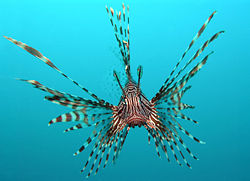
Lionfish - A problematic invasive species that might have escaped from an aquarium in Florida to breed amd wreck havoc in the caribbean.
A paper has recently been published by Gordon Copp, Lorenzo Vilizzi, and Rodolphe Gozlan in the journal Aquatic Conservation: Marine and Freshwater Ecosystems which eludes to the fact that the higher the population density in England, the more likely the natural ecosystems can be tainted with pet fish.
This is not a new piece of information. It has been known for quite some time that the ecosystems which are closer to roads, fish markets and pet shops are more likely to be subjected to pet fish than those which are not close to these avenues.
The object of the study was to perform a statistical analysis to take a look at the spacial relationships between pet fish contamination and the demographics which led to these fish being released into the wild, and also to test whether or not these demographic factors are a reliable way of estimating how many alien species are introduced into these ecosystems.
The case study was carried out using an intermediate scale for all of England, dividing the country into 1500 squares of 10 square kilometers each.
The study consisted of the following data sets to be used in their analysis: non-native fresh water fish occurrences in the wild; the numbers of non-native fish imported, and demographic information such as: numbers of humans, pet shops, garden centers and fish farms per unit area.
The study found that the incidences of pet fish contamination directly co-related to the density of the human population.
If you would like to learn more check out the paper: Copp, GH, L Vilizzi and RE Gozlan (2010) The demography of introduction pathways, propagule pressure and occurrences of non-native freshwater fish in England. Aquatic Conservation: Marine and Freshwater Ecosystems 20, pp. 595–601.


